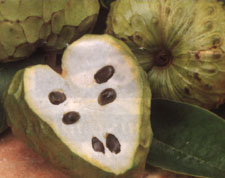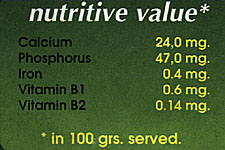

Custard Apples/Cherimoya
The Annona trees produce a variety of delicious fruits which are generally known as custard apples. All the fruits in this family are multiple fruits, make up of sections that grow together. The pulp is soft, suggesting the consistency of custard, and it is full of shiny, black seeds.
Most of the annona fruits originated in the American tropics, but nowadays they are cultivated in places like Asia, Australia, Spain and, in particular, Israel. Plantings are also increasing in California. The cherimoya began its history in Peru, where it is regarded as one of the finest fruits in the world.
Cherimoya: The most commonly known and arguably best, species. The skin of the cherimoya (Annona cherimolia) greenish-gray with a scaled pattern. The white pulp is sweet and perfumed, forming a natural custard in its own right. Flavors are reminiscent of pineapple, banana and guava, but truly a flavor of its own. The cherimoya is ripe when soft at touch and the outside turns a darker color. This doesn't affect the quality, on the contrary, it indicates that the fruit is in the best stage of sugarness and taste.
Sugar Apple: Often regarded as the true custard apple. this fruit (Annona squamosa), is sweeter than the cherimoya. It has a yellowish-green skin, which is made up of strange fleshy scales. When fully ripe, the scales burst open to reveal a creamy pulp, which is extremely sweet and slightly grainy.
Soursop: Larger than the other types, the soursop (Annona muricata) can weigh up to eight ounces. The thin skin has rows of dark-green, curved spines and the white pulp has a refreshing, sour-sweet flavor, more acidic than the other annona fruits.
Bullock's Heart: Not as good in flavor as the others. The appearance of bullock's heart (Annona reticulata) is suggested by its name. It has a brownish-red skin with a scaly surface and the pulp is sweet and granular.
Atemoya: A fruit with great potential, the atemoya (Annona atemoya) is a cross between the cherimoya and the sugar apple. It was developed in Florida. The pulp is sweet-tasting and the skin is light-green and bumpy. This fruit travels well.
Buying & Storing:
When buying annona fruit. be careful not to pierce the surprisingly delicate skin. Choose slightly soft fruit-the fruit can be opened in a dark room for a few days and may be refrigerated for a short time.
Preparation & Cooking:
The delicious pulp of annona fruit is best eaten raw and slightly chilled. Simply halve or quarter the fruit and scoop out the pulp with a spoon. The seeds are not eaten, so the pulp is quite often sieved to remove them. This produces a sweet puree which can be served as an aromatic custard.
Combined with a little whipped cream, the puree makes a delicious fruit fool. It also makes a tasty ice cream and sorbet, and is an excellent addition to trifles, soufflés and mousses.
Watered down and pepped up with a little lemon or lime juice, and sugar, the puree forms an exotic milk shake.
Deamer 4/4/97